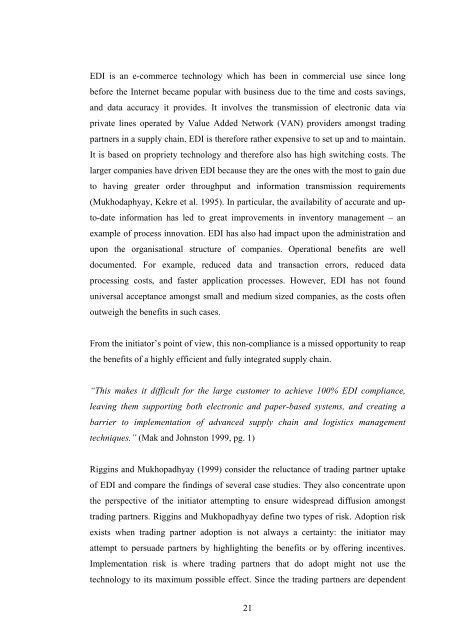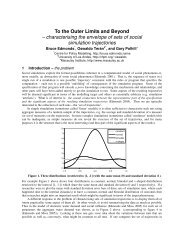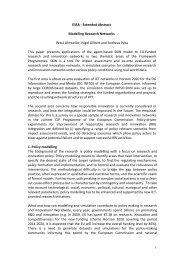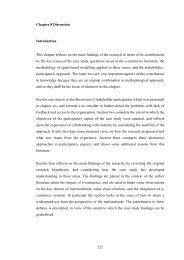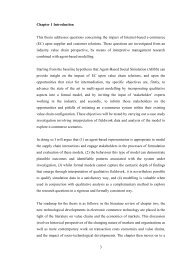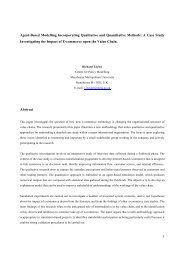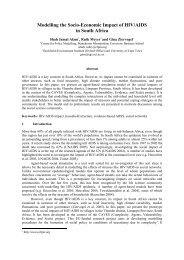7 Chapter 2 Literature Review: Markets, Intermediation and E ...
7 Chapter 2 Literature Review: Markets, Intermediation and E ...
7 Chapter 2 Literature Review: Markets, Intermediation and E ...
Create successful ePaper yourself
Turn your PDF publications into a flip-book with our unique Google optimized e-Paper software.
EDI is an e-commerce technology which has been in commercial use since long<br />
before the Internet became popular with business due to the time <strong>and</strong> costs savings,<br />
<strong>and</strong> data accuracy it provides. It involves the transmission of electronic data via<br />
private lines operated by Value Added Network (VAN) providers amongst trading<br />
partners in a supply chain. EDI is therefore rather expensive to set up <strong>and</strong> to maintain.<br />
It is based on propriety technology <strong>and</strong> therefore also has high switching costs. The<br />
larger companies have driven EDI because they are the ones with the most to gain due<br />
to having greater order throughput <strong>and</strong> information transmission requirements<br />
(Mukhodaphyay, Kekre et al. 1995). In particular, the availability of accurate <strong>and</strong> upto-date<br />
information has led to great improvements in inventory management – an<br />
example of process innovation. EDI has also had impact upon the administration <strong>and</strong><br />
upon the organisational structure of companies. Operational benefits are well<br />
documented. For example, reduced data <strong>and</strong> transaction errors, reduced data<br />
processing costs, <strong>and</strong> faster application processes. However, EDI has not found<br />
universal acceptance amongst small <strong>and</strong> medium sized companies, as the costs often<br />
outweigh the benefits in such cases.<br />
From the initiator’s point of view, this non-compliance is a missed opportunity to reap<br />
the benefits of a highly efficient <strong>and</strong> fully integrated supply chain.<br />
“This makes it difficult for the large customer to achieve 100% EDI compliance,<br />
leaving them supporting both electronic <strong>and</strong> paper-based systems, <strong>and</strong> creating a<br />
barrier to implementation of advanced supply chain <strong>and</strong> logistics management<br />
techniques.” (Mak <strong>and</strong> Johnston 1999, pg. 1)<br />
Riggins <strong>and</strong> Mukhopadhyay (1999) consider the reluctance of trading partner uptake<br />
of EDI <strong>and</strong> compare the findings of several case studies. They also concentrate upon<br />
the perspective of the initiator attempting to ensure widespread diffusion amongst<br />
trading partners. Riggins <strong>and</strong> Mukhopadhyay define two types of risk. Adoption risk<br />
exists when trading partner adoption is not always a certainty: the initiator may<br />
attempt to persuade partners by highlighting the benefits or by offering incentives.<br />
Implementation risk is where trading partners that do adopt might not use the<br />
technology to its maximum possible effect. Since the trading partners are dependent<br />
21


